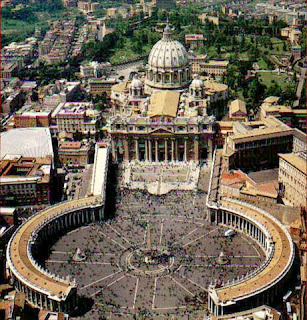There is a sign within Christianity that most of us know nothing about. The Mandorla, also referred to as vesica piscis, was used during medieval Christianity. It is an ancient symbol of two circles coming together and overlapping one another to form an almond shape in the middle. The meaning of the Mandorla depicts the interactions and interdependence of opposing worlds and forces. The symbol has its origins from the Kabbalah, before the Christian era. The early Catholics used the symbol as a way to describe the coming together of heaven and earth, between the divine and human.[1]
Mandorla is the Italian word for almond. During medieval times, the almond was used as a symbol for the woman's vulva. In time, early Catholicism incorporated the Mandorla into many paintings and artwork of the time.
As you may recall from earlier studies, the Vatican has a fascination with pagan symbolism that relates to the reproductive organs. As you can see, the obelisk (Baal's shaft) is within the vagina at St. Peters Basilica in Rome.
The following pictures demonstrate how Catholicism has used the Mandorla within its artwork.
The Mandorla is known both in the East and West. It has been used in false religions and in the secret societies. The Mandorla offers opposites, just as esoteric and exoteric symbols offer opposite or unrelated meanings.
Mandorla is the Italian word for almond. During medieval times, the almond was used as a symbol for the woman's vulva. In time, early Catholicism incorporated the Mandorla into many paintings and artwork of the time.
As you may recall from earlier studies, the Vatican has a fascination with pagan symbolism that relates to the reproductive organs. As you can see, the obelisk (Baal's shaft) is within the vagina at St. Peters Basilica in Rome.
The following pictures demonstrate how Catholicism has used the Mandorla within its artwork.
The Black Stone of Mecca - Kaaba Stone
The Black Stone is a Muslim object of reverence, which according to Islamic tradition, dates back to the time of Adam and Eve. Many consider it to be a Tektite. It is the eastern cornerstone of the Kaaba, the ancient sacred stone building towards which Muslims pray, in the center of the Grand Mosque in Mecca, Saudi Arabia.
When pilgrims circle the Kaaba as part of the Tawaf ritual of the Hajj, many of them try, if possible, to stop and kiss the Black Stone, emulating the kiss that it received from the Islamic prophet Muhammad. Researchers have noted that the Kaabah is accurately aligned on two heavenly phenomena - the cycles of the moon and the rising of Canopus, the brightest star after Sirius.[2]
Pastor Mike Hoggard shares his findings in the Scriptures that relate to the Mandorla and the Kaaba.
There are ways the Mandorla is being used in today's business logos and it has been used in movies, like Harry Potter.
Now that we are informed, let's watch to see how this symbol is used by the world in the coming days. Pastor Hoggard feels it may have implications of the coming Imam Mahdi.






















